Usually whizzed through as part of the famous Ring of Kerry Drive, Valentia Island doesn’t get the attention it rightly deserves. One of about 20 inhabited islands off Ireland’s coast, it’s easily accessed from the mainland and it’s worth spending a night or two either on the island or close by, enjoying its sights and walks at a more leisurely pace. At just 11kms in length and 3kms in width, the highlights can be ticked off in a full day’s touring but Valentia also serves as a good base for a longer stay.

The starting point is the lovely fishing village of Portmagee on the other island (what locals call the mainland!!).

A campaign for linking Valentia with the mainland started as far back as 1911, but was shelved due to World War 1 and subsequently the 1916 Rising, the War of Independence and the Civil War. A bridge linking Portmagee with the island finally opened in 1970. It was named in memory of Maurice O’Neill, a young local farmer executed in 1942 for republican activities.


Immediately across the bridge is The Skellig Experience where an exhibition documents the life and times of the Skellig monks and the islands’ extensive wildlife. The museum is well worth a visit, especially if you don’t manage a boat trip to the islands.

Knightstown is the island’s ‘capital’ (there are only a few other small settlements here on the island).
The Knight of Kerry, also called the Green Knight, is one of three Anglo-Irish hereditary knighthoods (all belonging to the Fitzgerald dynasty) which existed in Ireland since feudal times.
The Fitzgerald family began to reside on Valentia in 1780, renting from a Lord Orkney. The 18th Knight of Kerry bought out the estate in 1807. The island was rather unusual for its time in that its landlord actually lived on the island. Even more unique, The Knights of Kerry were reputed to care for their tenants and the island as a whole. They developed industries including flax and mining and built infrastructure including the seaport and Knightstown.

Everything centres around the port. Fishing was once a major industry here. It was said in 1825 there were 252 sailing boats and 271 rowing boats fishing from the island. The industry seems to have failed by the early 1900’s, leading to mass seasonal migration to England or emigration to Britain and the US. Those that still fish today land their catch elsewhere.

Nowadays, business is confined to the leisure industry and the seasonal car ferry. Running from April to October, the ferry will take you to the mainland in just about 10 minutes.


There’s a lovely job done on the original 1880’s Weighhouse. The lower section housed the scales – manly used for coal. When horse and cart was the mode of transport, the cart was weighed first, the coal was loaded and the difference was what was paid for… The Knight of Kerry wanted to make the building more pleasing to the eye so the clock tower was added. The clock survived until 1922 when it was ‘decommissioned’ by some Free State Soldiers. It was restored in 1990.

The Coast and Cliff Rescue Cart dates from 1902.

In the 1840’s, carpenter Thomas Young built the Valentia Hotel on the site of an old inn. It became the Royal Valentia Hotel after a visit from Prince Arthur (son of Queen Victoria) in 1869. The eyecatching building still operates as a leading hotel.

It’s hard nowadays to imagine the logistics of communicating between Europe and North America by boat alone. Weather permitting, the delivery of messages took at least two weeks. The idea of a transatlantic cable must have seemed an impossible dream.
Efforts began in the mid 1800’s but distance and depth presented formidable challenges. Several attempts by US and English naval vessels were unsuccessful until finally, in 1866, a cable was laid the full 1686 nautical miles between Valentia and Newfoundland. The first message was “A treaty of peace has been signed between Austria and Prussia”. Queen Victoria sent a message to the US President “The Queen congratulates the President on the successful completion of an undertaking which she hopes may serve as an additional bond of Union between the United States and England.”
Of course, this wonderful new service was not available to all – only the very wealthy could afford it. The initial rate was $1 per letter when the monthly wage for a labourer might be $20.
The cable maintained its importance right up until the 1960’s when the first communication satellites offered a serious alternative to the cable. In 1966 the Transatlantic Cable Station closed its doors for the last time.




Cromwell Point Lighthouse is maintained by the Commissioners of Irish Lights to guide vessels through the northern entrance of Valentia Harbour.
The site was originally home to one of two 17th century Cromwellian Forts built on the island. There’s been a lighthouse here since 1841. Originally the lighthouse was staffed by a single keeper, housed with his family on site, however with automation the keeper was withdrawn and a part-time attendant was appointed to look after the station.
Today, it’s one of the island’s prime tourist attractions with some 15,000 visitors annually.



The Valentia Island Tetrapod footprints discovered in 1991 have been hailed by geologists as the earliest fossilized examples of a prehistoric creature in Europe, and possibly in the world. Thought to date from Devonian times – somewhere between 350 and 370 million years ago -the footprints represent the transition of life from water to land – a momentous turning point in evolution. They provide the oldest reliably dated evidence of four-legged vertebrates – amphibians – moving over land. The Valentia trackway is the most extensive of only four Devonian trackways in the world (there is one in Scotland and two in Australia).


The Tetrapod was 1 metre in length, one third of which was its tail. The trackway was formed when the Tetrapod walked over a soft silty floodplain, leaving footprints, body and tail marks behind.


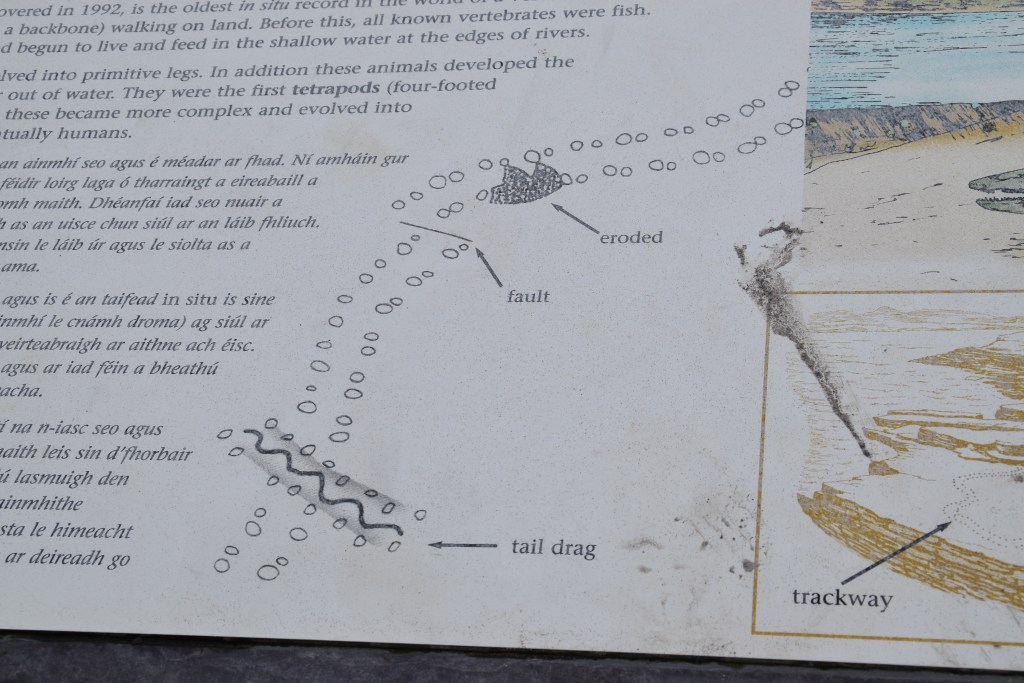
The Slate Quarry first opened in 1816 under the direction of the Knight of Kerry. It was famous for its quality and provided the slate for the Paris Opera House, London’s Houses of Parliament and many billiard tables, including one made for the Duke of Wellington & Queen Victoria. At its height, over 200 people worked here but eventually it couldn’t compete with Welsh slate mines and closed. It was revived by local businessmen a number of years back and today, the slate is used for counter tops, roof slate, etc.


In 1954 – the Marian Year – statues of Our Lady and Bernadette were installed high above the quarry entrance.
In 1854, Pope Pius 1X defined the dogma of The Immaculate Conception of the Virgin Mary. Pope Pius X11 ordered a Marian Year for 1954 to mark the centenary of the dogma. Another Marian Year was initiated in 1987 by Pope John Paul 11 in preparation for the forthcoming millennium. In 1954 in particular, grottos such as this were set up all over the country – although not usually in as striking a location!


Geokaun Mountain is the highest point on Valentia and offers 360° views – even on a dull day! (Note – There is an access charge – €6 per car)

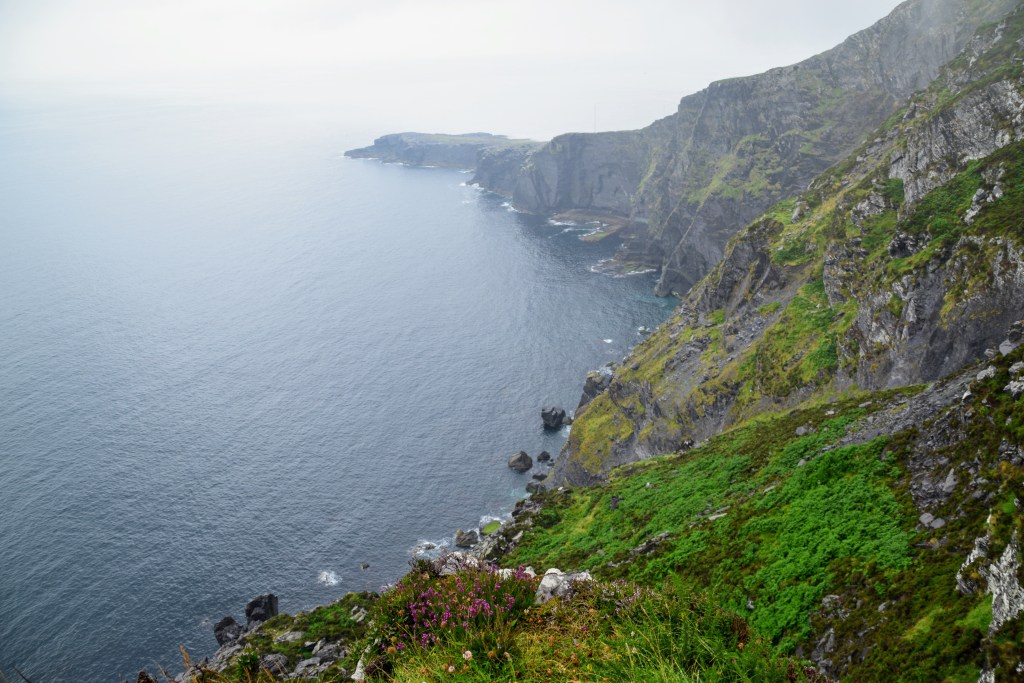
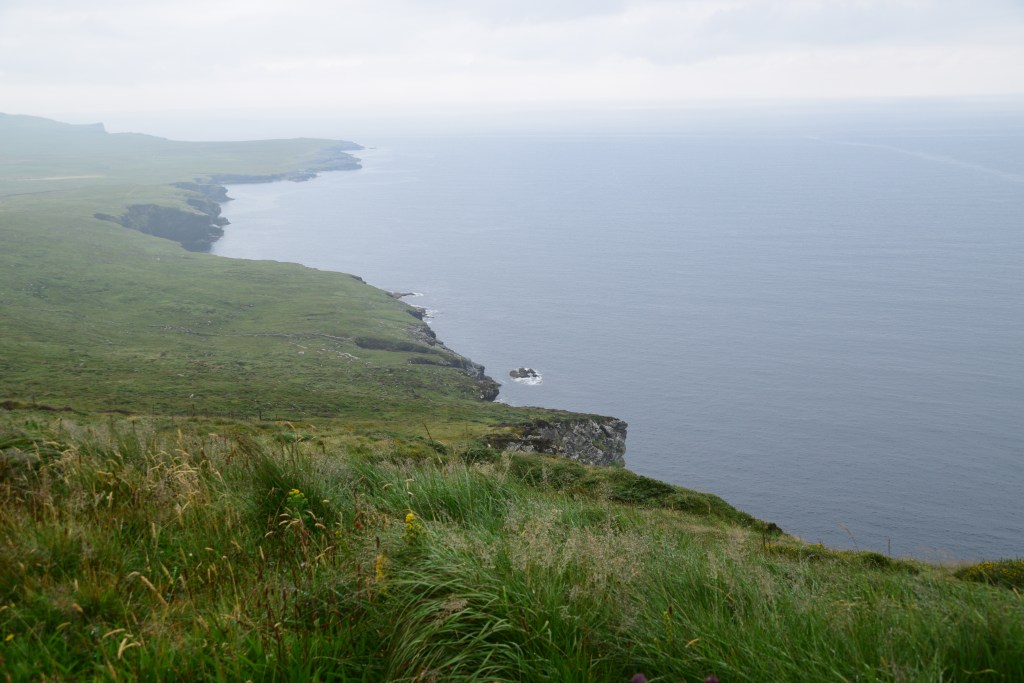




Emigration is an ongoing problem here with many choosing to go to the other island (Ireland) and further afield to Britain and the US.
A Free Emigration programme was introduced when Ireland was being hit by a second famine. In order to qualify, one had to give up one’s holding and the whole family had to leave.
In June 1883, two ships took 1,200 people from the Iveragh Peninsula to America. As a result, the two old villages of the island, Clai na Cartan and Cnochan Cora Beg were decimated. Clai na Cartan had 50 houses in 1800 with 1 house remaining in the 1901 census.
Ballyhearney National School had 253 pupils before the 2nd ship sailed – the following week there were 46.
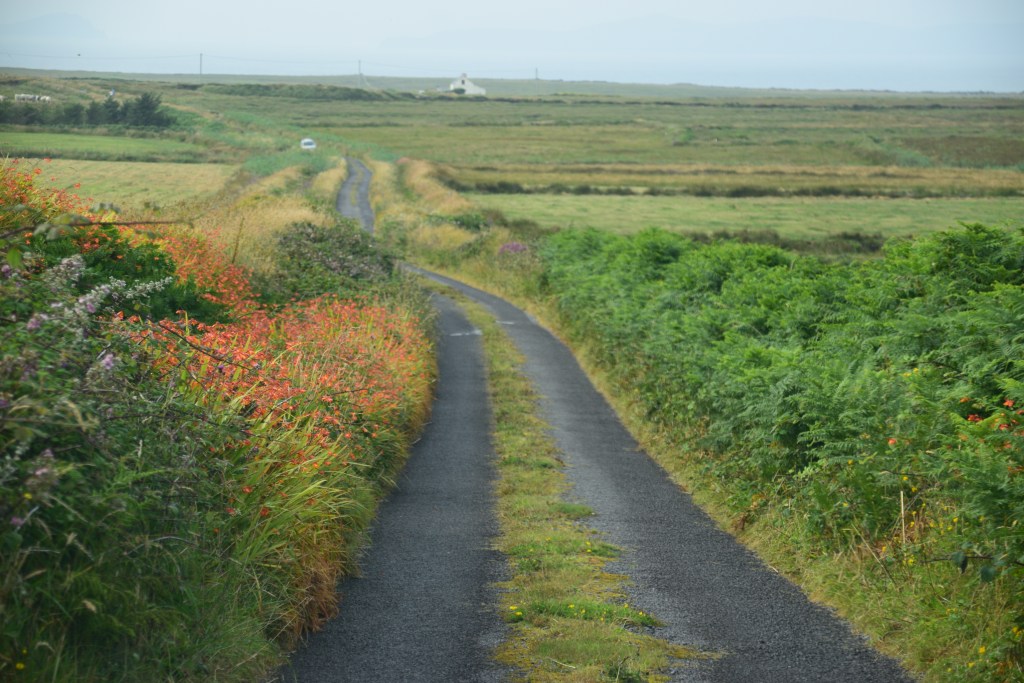
There are a number of holy wells on Valentia, associated with early Celtic saints – some still attracting pilgrims. One such well – in a bog in the middle of nowhere – is dedicated to St. Brendan. Legend has it that he sailed here from Dingle in the 5th century, scaled the cliffs and baptised two dying pagans. It’s worth seeking it out for the views alone.
Known as the Navigator, Brendan (circa 489 – 583) is the patron saint of mariners and travellers. The most adventurous of all Irish saints, he visited Britain and many of the Scottish Isles. A 9th century manuscript – Navigatio Sancti Brendani Abbatis (Voyage of St. Brendan the Abbot) – tells the story of his most famous voyage in search of Hy Brasail (Island of the Blessed). Lasting seven years, this voyage took Brendan and a small group of monks probably to Iceland, Greenland and very possibly America – some believe that the flat, warm land he described was in fact Florida.
In the 1970s, explorer Tim Severin read Navigatio Sancti Brendani Abbatis. Between May 1976 and June 1977, Severin and his crew sailed the ‘Brendan’ – a replica of Brendan’s boat – 7,200 km from Ireland to Newfoundland, stopping at the Hebrides, Faroe Islands and Iceland en route. The success of this project proves that St Brendan may have been the first European to set foot in America!!
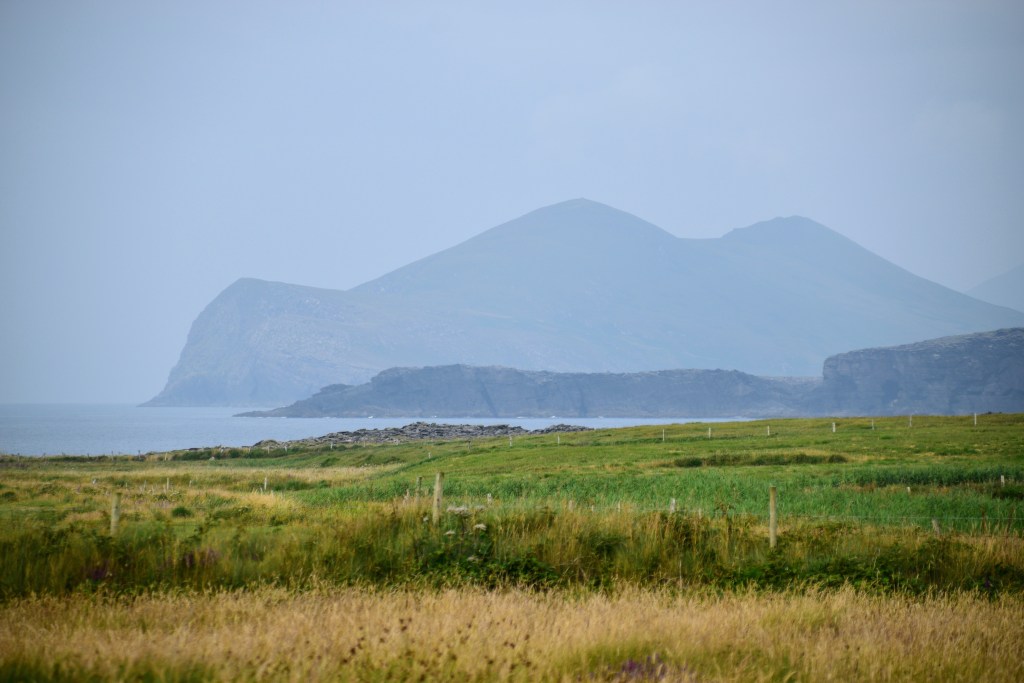

Hopefully, you’ve still a bit of time and energy for one more walk – because you can’t leave Valentia without climbing up to Bray Head Tower. The 2km gentle incline is worth the effort for fabulous views of the Skelligs, Blaskets, Valentia, the Dingle Sound, and the Iveragh Peninsula. .

Looking across at the Kerry Cliffs on the other island….

…. and out towards the Skelligs…



The tower is one of several along the west coast, built by English forces in 1815 during the Napoleonic wars. They were constructed in view of each other so that signals could be passed in the event of attack. It was used up until the 1920’s by naval authorities as a signal station and again occupied by coast watchers during the ‘Emergency’ (World War II).

The tower itself is of little interest but the views are something else up here!



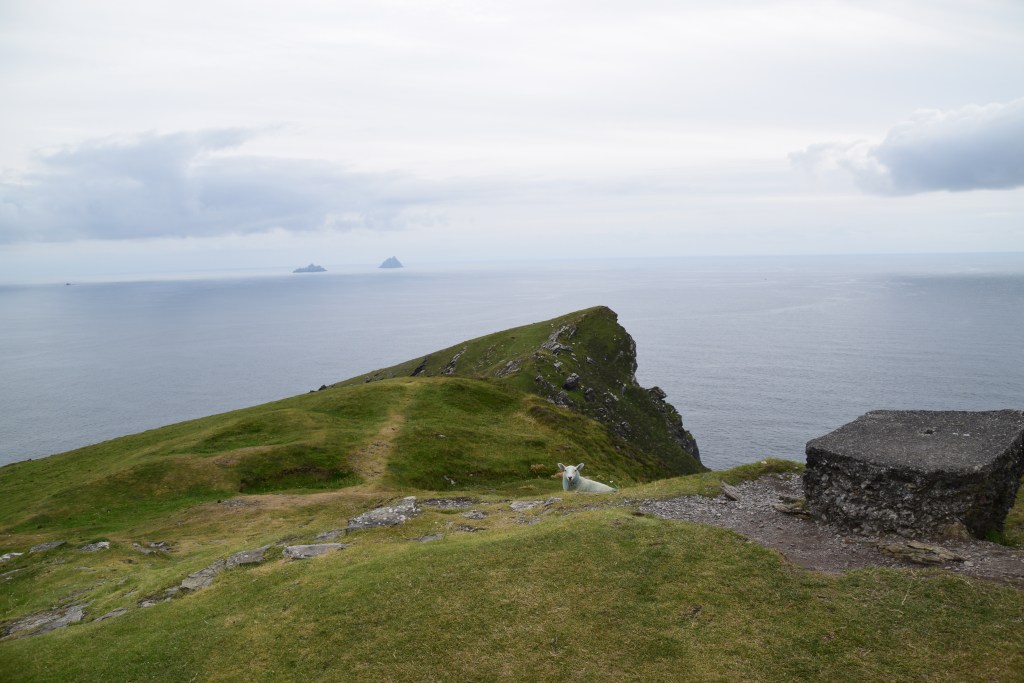
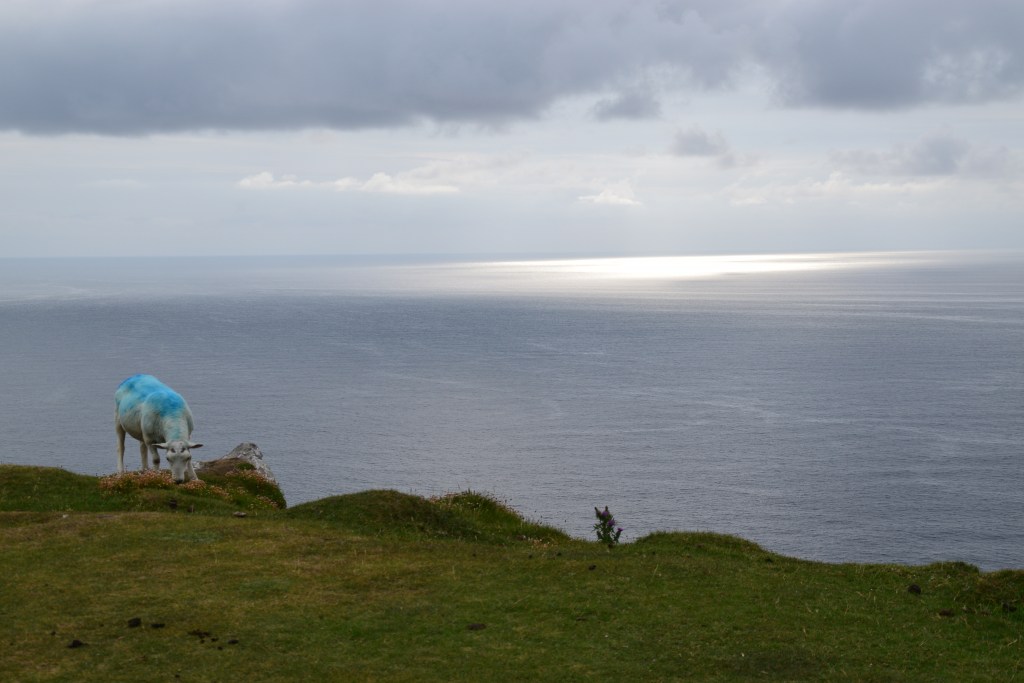











Very interesting site to see
.so much history.
Isn’t there – for such a small place!!!
In 2013, we looked longingly across to Valentia from Portmagee, but did not have the time to go over. Thanks for showing us the Island Marie. Allan
Sure we were always the same – although last year went over for about an hour to have a look when driving the Ring. When we booked Skellig Michael this year, I allowed a day for Valentia as well. Glad I did…
I love Valentia Island, its rugged coast, the Clock Tower and the beautiful lighthouse. So far I’ve only seen it across the waters from Cahersiveen and somehow, usually due to the shortage of time, because there are always so many other things to see and do, we’ve never made it to the island. I hope to visit one day 🙂 Aiva xx
This time I booked 4 nights in Caherciveen so could concentrate on the area. We’d one day on Skellig Michael, one day on Valentia and one very wet day so couldn’t do much. It worked out well….
So many things to see on such a small island! I love the coastal views and the story of St Brendan possibly reaching America 🙂 And those ancient footprints are amazing! But I’m surprised there’s enough business for a car ferry if there’s a perfectly good bridge linking the island to the mainland?
I’d say the ferry is a bit of a novelty event but seemed to be very busy… It could make a nice loop for cyclists. We couldn’t believe how much there was to see… a great day out!!
Such an interesting island, with so much history. I’ve never heard of either so thanks for posting, maybe I’ll get there one day
I loved all the stories once I got into it – you’re right – so much for such a small place. XXXM
Thank you for showing me a place I’d never heard of. The Skellig Monks’ history sounds really interesting and I particularly love that view over to Portmagee 🙂
The Ring of Kerry is a famous drive in the south west – but its quite long so most visitors, who usually tackle the Ring in a day, don’t have time to really slow down and enjoy. Portmagee is lovely – we whizzed through it last year on a lovely summer’s evening with people sitting around enjoying their pints and seafood. I decided that I’d have to get back sometime and allow time to do the same thing. And we did this year!!!
A lovely exploration and some fascinating history. I’ve driven around the Kerry peninsula a couple of times, years apart, and would never have known! I’m guessing there are many hidden gems in that rocky ocean-swept corner of Ireland.
You’re probably like us – ‘doing’ the Ring in one day – which is what most people do. Even last summer we set off in the morning and had only reached Valentia by about 5.00pm!! So of course the rest of the route had to be rushed. We finally tried a new tactic this year – ignoring most of the peninsula and heading straight to Caherciveen.. and it worked!!
Not sure if you’ll even read this as I don’t know whether my comments stay up or disappear, but lovely evocation of Valencia, a place most people only know of from the weather forecast!
Yes Mari – your comments are coming and staying. I forgot the mention the weather station!!!!
Thank you for the tour Marie, so much history for a such small island. Never heard about that tetrapod, so interesting..
I didn’t know about the tetrapod either until we were in the area last summer – but it was late evening and we couldn’t actually find it so it was yet another thing to check out if we’d ever return to the region – I didn’t think we’d be back there so soon again. Of course it wasn’t difficult to find at all!!!
This is a very complete article. I’ve been to the island several times but haven’t seen as much.
This was the first time we’d ever actually devoted time to the place so could properly hunt down the ‘best things to see and do’… same thing no matter where we go I suppose…..
I’m impressed that you take the time to explain the extensive history of this island from the perspective of the island’s importance to the people back then.
It puts a whole different context on the place doesn’t it, knowing the background….